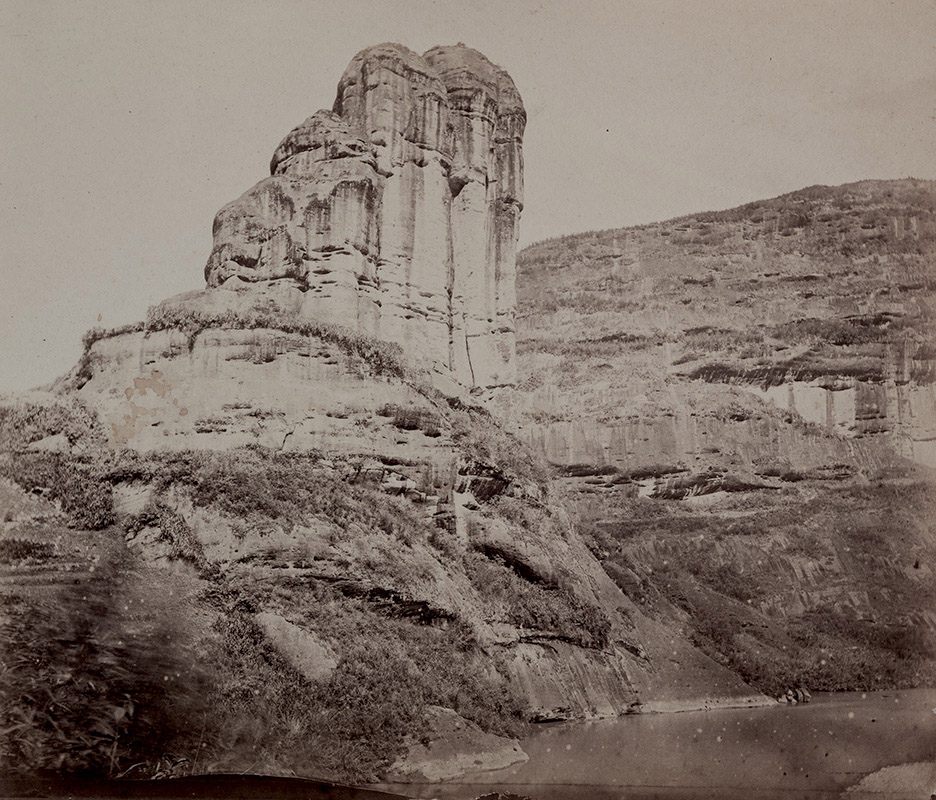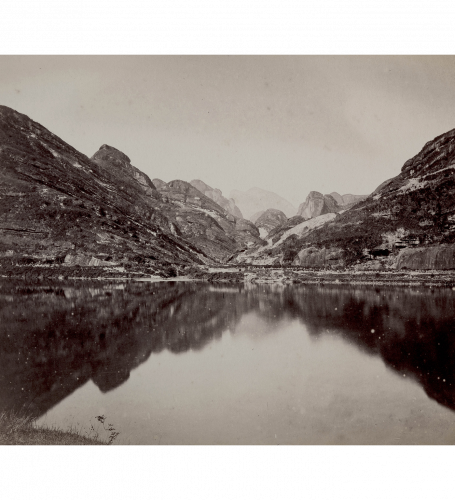

Tung Hing Studio
1870s
Albumen silver print
21 x 29 cm
From the Loewentheil Collection
同兴画楼
1870年代
蛋白印相
21 x 29 厘米
洛文希尔收藏
The Loewentheil Collection includes masterpieces by the Tung Hing Studio in Fuijan, Fuzhou. Scholars regard the works as pinnacles of late Qing dynasty landscape photography. The Tung Hing Studio created artistic views of this magnificent landscape, revered for generations by leading poets and philosophers. The works express a traditional literati aesthetic long associated with the grand Chinese landscape portrayed. The exceptional series of photographs created in the Wuyi Mountains are unmatched in their sensitivity, reflecting traditional landscape painting, shanshui hua. Each view in the series is an unparalleled, integral photograph. When seen together, the series forms an expansive and encompassing embrace of the region. Tung Hing Studio captured the Wuyishan in an ethereal, timeless state. The resulting photographic prints are objects of contemplation as well as enjoyment.

Tung Hing Studio. Wuyishan. 1870s.

Tung Hing Studio’s view of the famous Jade Maiden Peak is part of the artist’s series of photographs of the picturesque Wuyi mountain range in the remote northeast corner of Fuijan. To make the photographic prints of Wuyishan, Tung Hing Studio used glass plate negatives meticulously coated and developed on site. This achievement required the transportation of a cumbersome dark room tent, glass plates, and chemicals on a river boat and through rocky terrain and wilderness. The effort and time undertaken to achieve the masterpiece was great. The artist required precise lighting and weather conditions to capture this exquisite view. The graceful yet imposing geological formation of Jade Maiden Peak is said to resemble a beautiful girl.
The Earliest Photographs of the Most Beautiful Mountain Range in Southeast China
The Wuyi Mountain range is considered the most beautiful mountain range in southeast China. The earliest photographers of China felt compelled to create photographs of the scenic wonder. They travelled with their fragile photographic equipment on small boats and bamboo rafts along the nine-bend river to capture the earliest images of the stunning geological spectacles.
In addition to the region’s picturesque scenery, Wuyishan is famous in China and around the world for its tea heritage. Wuyishan is the birthplace of oolong tea. Photographers captured early images of terraced tea plantations and late Qing Dynasty tea harvesting practices.
The natural beauty and rich tea heritage that attracted China’s pioneering photographers to Wuyishan was internationally recognized in 1999 when UNESCO declared Mount Wuyi to be a natural and cultural World Heritage Site.

In the Wuyi Mountains reside Immortal spirits.
At the foot of the Mountains flow cold meandering clear streams.
Longing for seeing the unexpectedly remarkable place within,
one hears the sporadic singing of the songs of oars at leisure.
—— Excerpt from the Song of Oars of the Nine-bend Stream by Zhu Xi (1130-1200) from the Song dynasty
武夷山上有仙灵,
山下寒流曲曲清。
欲识箇中奇绝处,
棹歌闲听两三声。
——宋 · 朱熹《九曲棹歌》节选
For permissions and inquiries please contact:
446 Kent Avenue PH-A Brooklyn, NY 11249 USA